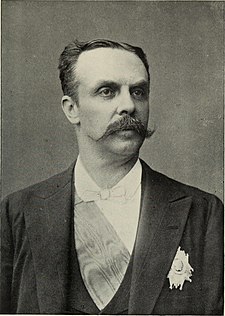Jean Casimir-Perier
| Jean Casimir-Perier | |
|---|---|
 | |
| 6. prezident Francie | |
| Ve funkci: 27. června 1894 – 16. ledna 1895 | |
| Předchůdce | Sadi Carnot |
| Nástupce | Félix Faure |
| Stranická příslušnost | |
| Členství | Republikánská levice |
| Narození | 8. listopadu 1847 Paříž |
| Úmrtí | 11. března 1907 (ve věku 59 let) Paříž |
| Místo pohřbení | Kaple Casimir-Périer de Pont-sur-Seine |
| Choť | Hélène Casimir-Perier |
| Rodiče | Auguste Casimir-Perier a Camille Fontenilliat |
| Děti | Claude Casimir-Perier Germaine Sommierová |
| Příbuzní | Q110015893 (sourozenec) |
| Alma mater | Condorcetovo lyceum Pařížská univerzita |
| Profese | politik a diplomat |
| Náboženství | katolická církev |
| Ocenění | velkokříž s řetězem Řádu Karla III. (1894) Všeobecná soutěž velmistr Řádu čestné legie velkokříž Řádu čestné legie |
| Commons | Jean Casimir-Perier |
| Některá data mohou pocházet z datové položky. | |
Jean Paul Pierre Casimir-Perier (8. listopad 1847, Paříž – 11. březen 1907, tamtéž) byl francouzský politik a francouzský prezident v letech 1894 a 1895. Casimir-Perier byl zvolen prezidentem po zdařeném atentátu na předchozího prezidenta Sadi Carnota. Stalo se tak podle francouzské ústavy tři dny po atentátu, dne 27. června 1894 na zasedání kongresu, složeného ze senátu a poslanecké sněmovny, jeho vítězství bylo jasné hned při prvním hlasování, ke zvolení bylo zapotřebí 423 hlasů, Casimir-Périer jich obdržel 451. Jeho jediným vážnějším soupeřem byl Dupuy. Rodina nového prezidenta náležela k tak zvaným republikánským dynastiím. Jeho otec byl původně bankéřem, později jedním z vynikajících státníků.
Odkazy
Literatura
- Světozor č. 33, ročník XXVIII (1894)
Externí odkazy
 Obrázky, zvuky či videa k tématu Jean Casimir-Perier na Wikimedia Commons
Obrázky, zvuky či videa k tématu Jean Casimir-Perier na Wikimedia Commons
Média použitá na této stránce
Autor: Internet Archive Book Images, Licence: No restrictions
Identifier: evolutionoffranc00coub (find matches)
Title: The evolution of France under the third republic
Year: 1897 (1890s)
Authors: Coubertin, Pierre de, 1863-1937 Hapgood, Isabel Florence, 1850-1928. tr
Subjects:
Publisher: New York (etc.) T. Y. Crowell and company
Contributing Library: Robarts - University of Toronto
Digitizing Sponsor: University of Toronto
View Book Page: Book Viewer
About This Book: Catalog Entry
View All Images: All Images From Book
Click here to view book online to see this illustration in context in a browseable online version of this book.
Text Appearing Before Image:
is it was tochoose his battle-ground, to fortify his positions, toregulate the attack for the grand battle of the autumn.M. Constans was looked upon as an energetic and skil-ful man; he showed himself equal to his reputation.His first measures immediately conveyed an idea of theconception which he had of his part. He hesitated notto prosecute the League of Patriots,^ nor to discourage 1 The President of the Republic had had M. Tirard summoned afterthe failure of a combination of Meline, Ribot, and Casimir-Perier. Theministry comprised MM. Spuller (Foreign Affairs), Constans, Rouvier,de Freycinet, Fallieres, Thevenet, Yves Guyot, and Admiral Krantz, whodied shortly after, and was replaced by Admiral Jaures. - Atchinoff, a Cossack adventurer, disclaimed by Russia, had installedhimself at Sagallo. The neighborhood of Abyssinia rendered possibleintervention on the part of Italy. So Atchinoff was ordered to withdraw,and refused. Our cruisers, with a little too much precipitation, then bom-
Text Appearing After Image:
JEAN CASIMIR-PERIER, FIFTH PRESIDENT OF THE REPUBLIC. THE CRISIS. 235 the labor agitation organized by the syndicates andindependent collective groups of the Seine, nor to openthe doors of France to the Due dAumale, nor to sus-pend the secularization of the asylums which had alreadybeen ordered, nor, above all, to demand the passage ofa law to regulate the procedure of the Senate sitting asa Supreme Court of Justice. He caused some surpriseat first. Among those who were most disquieted at thespectacle of the progress of Boulangism, many werestill ignorant of the share of responsibility which Gen-eral Boulanger had therein, his corruption, his far-reaching calculations, his manoeuvres; they wondered,while the)^ felt conscious of his guilt, how the Senatewould succeed in proving a criminality of intentionsalone. The unexpected retirement of the attorney-general, who refused to prosecute the accused, trans-formed this doubt into excitement. With that profoundsense of justice which is inn
Note About Images
Autor: Dessiné par Jérôme BLUM le 5 septembre 2007. Készítette: Jérôme BLUM 2007., Licence: CC BY-SA 2.0 fr
unofficial emblem of the French Republic, created from France coa.png. The only official emblem of France is its tricolour flag.


